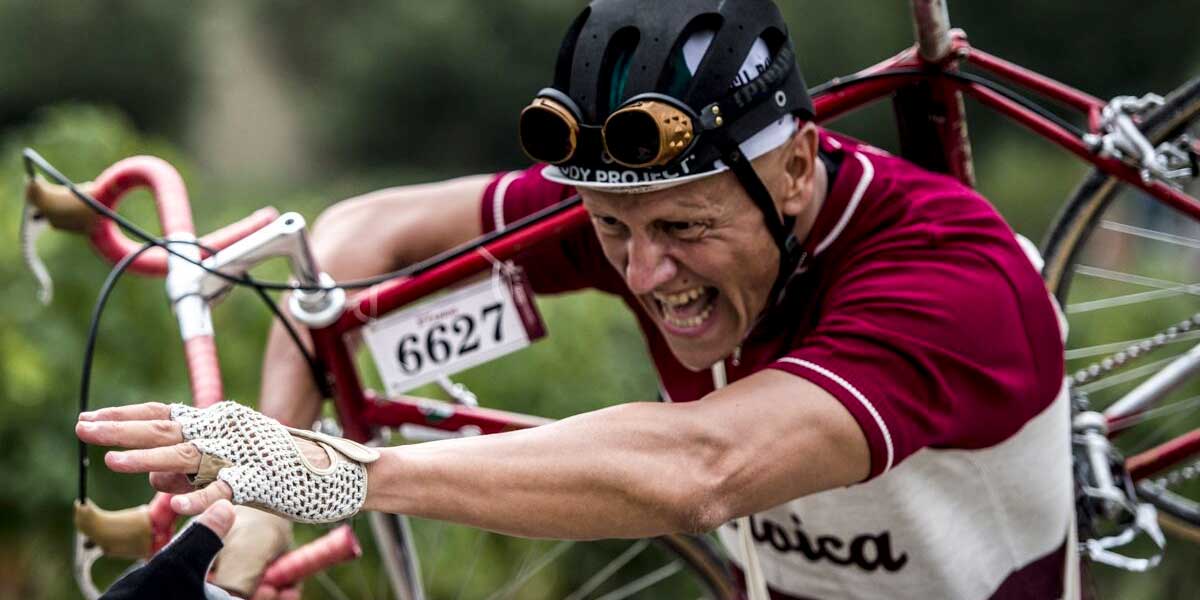Very early on, the Milano-Sanremo became known as “The Spring Classic” and then “La Classicissima”
Very early on, the Milano-Sanremo became known as “The Spring Classic” and then “La Classicissima” (Super-classic). Worth remembering is the first edition that dates back to 14 April 1907, the same year as Luciano Berruti's Peugeot, one of the most photographed bikes at L'Eroica. When an Eroica delegation, riding historical bikes, opened the race in 2010, Candido Cannavò, director of the Gazzetta dello Sport, dedicated an in-depth article precisely to Luciano's hundred-year-old bike.
The idea originated in Sanremo, because a small car race was held the year before on the Sanremo, Milan, Acqui Terme, Sanremo route. Only two teams finished it in two days and nothing but bar banter remained. Straight afterwards though, as a kind of payback, the idea of a cycling race starting from the Gazzetta headquarters in Milan and arriving in the City of Flowers
began to take shape.
Costamagna, director of the newspaper that had not yet invented the Giro d'Italia, reduced it to money terms, telling proponents that 700 lire should be sufficient to get the project off the ground. Giambattista Rubino, Stefano Sghirla and Marcello Ameglio immediately armed themselves, collected the sum and came back. Journalist, Morgagni managed things within the Gazzetta, while the technical side of things were left in the expert hands of Armando Cougnet. The most plausible and direct route, covering almost 300 km, was chosen from the Touring map. It has remained practically unchanged, descending the Turchino pass to reach the Riviera before taking on the Capes [three short hills along the coast, Capo Mele, Capo Cervo and Capo Berta, ndr].

That first edition wrote history, due to the bad weather and the battle between the Italians and the French, between Bianchi and Peugeot, the two biggest teams participating. The winner was Petit Breton, who already had a stellar list of titles. On the Italian side the protagonist was the Red Devil, Giovanni Gerbi from Piedmont, who fought for his Bianchi teammate and kept the other Frenchman, Garrigou, at bay in the sprint.
Riding so close to the border between the two strongest cycling countries in the world at the time, the Sanremo immediately took on legendary status, becoming practically epic in 1910 because of the extreme weather conditions, with a severe snowstorm scourging the peloton. Frenchman Eugène Christophe won, taking the race by a full hour. A true heroic cornerstone in cycling history, and the first Frenchman to wear the yellow jersey of the Tour de France, he lost the Tour twice due to fork breaks.
Year by year, The Milano-Sanremo, became a true global race, a point of reference, open to all cyclists, but really reserved for the great champions. The Sanremo Hall of Fame is like the “geological era” of cycling, with all the biggest names leaving their mark. Costante Girardengo, the first Campionissimo, won it six times, bringing together cleverness, consistency and an excellent sprint. Subsequent years were marked by Alfredo Binda, winning three editions and then by the epic years of Bartali and Coppi; four wins for Gino, three for Fausto, with at least one legendary edition each; that of '46 for Coppi, at the conclusion of an endless break; the last one in 1950 for Bartali in an unexpected group sprint in which the Tuscan, aged 36, clocked up another victory in his never-ending career. The story of the Milano-Sanremo is indelibly connected to the name of the Cannibal, Eddy Merckx, who started out as a green youngster and achieved an unsurpassed record of seven victories. The Belgian phenomenon imposed himself in a solo sprint, breaking away both uphill and downhill, a supremacy that marked the entire decade, with his first win in 1966 and his seventh, ten years later, in 1976.
Now, with speed and technology raising the bar, the Sanremo has become increasingly uncertain; modern cycling leaves no place for outsiders and today we often speak of the lottery to describe the uncertainty and lack of reliable predictions especially at the highest levels.
From an Eroica point of view, we cannot leave out the magnificent Erik Zabel, German champion between the two millennia, who has honoured the ride in Gaiole in Chianti with his presence for years now.
Giancarlo Brocci
In the photo Erik Zabel during L'Eroica, 2018
Photo: Guido Rubino

















